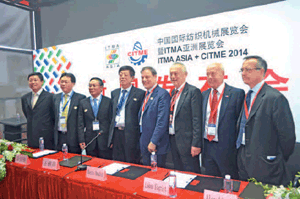
ITMA Asia? 2014 affirms No. 1 position in….
More than 1550 exhibitors and over 100,000 visitors, ITMA Asia? 2014 laid its claim successfully that it is the No. 1 textile machinery exhibition in Asia. The fourth combined ITMA ASIA CITME 2014 exhibition downed the curtains on June
ITMA Asia? 2014 affirms No. 1 position in AsiaITMA Asia? 2014 affirms No. 1 position in Asia
More than 1550 exhibitors and over 100,000 visitors, ITMA Asia? 2014 laid its claim successfully that it is the No. 1 textile machinery exhibition in Asia.
The fourth combined ITMA ASIA CITME 2014 exhibition downed the curtains on June 20, after having hosted over 1500 exhibitors from 28 countries. It lived up to its reputation of a democratic principle show of the Chinese, for the Chinese and by the Chinese. Taking up the largest exhibition area were Chinese exhibitors, booking slightly over 66 per cent. European manufacturers, taking over 22 per cent of the total exhibition space, were the next biggest contingent.
Wang Shutian, President of China Textile Machinery Association termed it as the biggest show in all Asia. The show held at the Shanghai New International Expo Centre, grossed 152,200 square metres in 13 halls, 15 per cent larger than the last edition in 2012.
All the European giants including Rieter, Saurer, Oerlikon, Loepfe, ITEMA Weaving, Biancalani, Picanol, Staubli, Van de Wiele had their huge stalls filled with innovations for the Chinese and other Asian markets. Vying for attention were other textile machinery giants from Asia, which included Tsudakoma, Toyota, and Shima Seiki. Most of the big-timers had some new machinery or the other for the fast-growing textile industry.
Visitors were mostly from China, and it was difficult to segregate the serious-minded ones from the frivolous crowd. There were a good number of serious visitors from India, may be those who had missed the Barcelona ITMA show in 2011. Young generation entrepreneurs from Surat were conspicuous by their presence, affirming the trend that this Gujarat city is fast becoming a bigger textile centre in India. Blue Competence was at the centre of Germany's concept of sustainability and reducing carbon footprints. During a guided tour initiated by the German VDMA Textile Machinery Association at ITMA ASIA CITME in Shanghai, high representatives from Chinese authorities and associations and the German General Consul in Shanghai, Dr Wolfgang Röhr could convince themselves of the energy saving equivalents enabled by German textile machinery.
German passion for thoroughness was evident in some of the explanations by the experts during the tour. For instance, consider T-shirts. The explanation goes thus: “Cotton T-shirts are part of the basic garment. German technology reduced 28 per cent of energy consumption for the production of jersey fabric during the past ten years. The saving effects – applied to the production of one T-shirt per year for each of the 7 billion inhabitants of the earth – are enormous: If the worldwide production of cotton T-shirts was made completely on German state-of-the-art technology the output of two coal power stations in Beijing with a total gross power of 1000 megawatt could be saved every year.”
If Germans did their mite for sustainability, Italians were not far behind. The latter sported their Green Label in every corner of Italian technologies and promised that the “Sustainable technologies” project launched four years ago by ACIMIT, the Association of Textile Machinery Manufacturers, knows no stop. The following figures testify the success of the ACIMIT initiatives, they claimed: 40 Italian manufacturers adhering to the project; – 530 green label issued from 2011 to date; the renewal of the certificate of conformity released in 2014 by RINA, an international certification body, as result of inspection audits at 7 member companies among those joined the project.
Most of the companies in every sphere in all the halls had something or the other to ensure energy savings in their machinery. It was simply a question of percentage. Waste recycling also played an increasingly higher role in the scheme of textiles.
Number of mac



